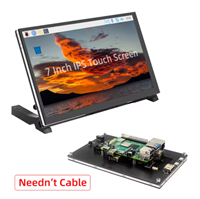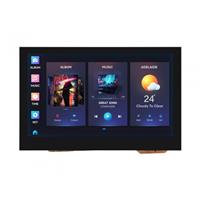Commodore 1581 Enhanced Drive Board (1581D/1582 build compatible)
If you're like me, you're thinking that you'd like to own a Commodore 1581 Disk Drive, but the crazy high prices have kept you away from realizing your dream. Well, here is your chance to build your very own Commodore 1581 replica disk drive.
This is my final revision where I've cleaned up some traces and refined the 1581D/1582 connections for linking two boards together when the builder wants to construct their own DUAL 1581 Drive (1581D/1582). This board is functionally identical to my other version posted here, just cleaned up some traces as as mentioned refined the link connection points.
This is my 1581 Enhanced board. The PCB itself is based on the original board design, and as such, is compatible with the original case. Placement of the ports and switches are in the original locations. I wanted to make this board for the community in a way that anyone wanting a 1581 with a bit of skill (or friends with the skills required to assemble this) could have one of these drives for a fraction of the cost of an original drive.
The board itself supports standard Amiga modified floppy drives, and with the Toms adapter board ( https://gitlab.com/toms01/1581-pc-drive-adapter ), all you need for a floppy drive is virtually ANY 1.44 IBM compatible floppy drive mech. The PCB supports single or dual drive ROMS, so you can for example have just the original DOS rom, or you can have JiffyDOS and the original rom (switchable from a jumper on the board).
I've also enhanced the board such that you no longer need to use an original Commodore 1541-II/1581 power supply. Once built, you can power this board with ANY power supply between 7.5 and 25VDC. Either powering methods have been maintained on the board, and are selectable with a single jumper setting. This means, if you want to power it with any power supply you have laying around within those parameters, you can. Or, you can power the drive with a factory power supply. Only one method can be active at any time, so no damage can occur. I implore you however to observe the polarity markings on the PCB when hooking power up to the Alternate power circuit. Always best to double check before applying power.
It has come to my attention through testing that the W65C02 is not TTL compatible. As such, I recommend only using the 6502 CPU on this board.
I'm also not restricting the use of this board. So you can purchase PCB's for yourself, or you can purchase a truck-load and sell them in your shop or on eBay. Do what you like with the boards. All I ask is if you're selling them, please link back to https://corei64.com . I am not however giving the Gerbers away, because providing them through PCBWay ensures you're going to get a quality product, and the small percentage I get from purchases of this board from PCBWay helps fund my ongoing efforts to provide other cool projects to our community.
Your support is always greatly appreciated.
I've created a Github for this project where you'll find photos, descriptive documents, BOM, everything you need to get this project going for yourself. Pick a PCB color, place your order and get building. If you have any questions, reach out to me through my shop, or on social media. I'm not hard to find.
Enjoy!
NOTE: This board has now been superceded by the v2.5 LED edition board.
Commodore 1581 Enhanced Drive Board (1581D/1582 build compatible)
*PCBWay community is a sharing platform. We are not responsible for any design issues and parameter issues (board thickness, surface finish, etc.) you choose.

Raspberry Pi 5 7 Inch Touch Screen IPS 1024x600 HD LCD HDMI-compatible Display for RPI 4B 3B+ OPI 5 AIDA64 PC Secondary Screen(Without Speaker)
BUY NOW
ESP32-S3 4.3inch Capacitive Touch Display Development Board, 800×480, 5-point Touch, 32-bit LX7 Dual-core Processor
BUY NOW
Raspberry Pi 5 7 Inch Touch Screen IPS 1024x600 HD LCD HDMI-compatible Display for RPI 4B 3B+ OPI 5 AIDA64 PC Secondary Screen(Without Speaker)
BUY NOW- Comments(21)
- Likes(20)
-
 Juan VM
Nov 23,2024
Juan VM
Nov 23,2024
-
 Engineer
Jun 14,2024
Engineer
Jun 14,2024
-
 Engineer
Mar 26,2024
Engineer
Mar 26,2024
-
 Michael Deient
Mar 17,2024
Michael Deient
Mar 17,2024
-
 Engineer
Feb 21,2024
Engineer
Feb 21,2024
-
 Engineer
Feb 08,2024
Engineer
Feb 08,2024
-
 Martin Maciaszek
Feb 04,2024
Martin Maciaszek
Feb 04,2024
-
 Akutra Cea
Nov 22,2023
Akutra Cea
Nov 22,2023
-
 Vittorio Rebecchi
Oct 09,2023
Vittorio Rebecchi
Oct 09,2023
-
 Njall Owen
Sep 04,2023
Njall Owen
Sep 04,2023
-
 Holger OnkelHolgi
Aug 17,2023
Holger OnkelHolgi
Aug 17,2023
-
 Zoltan Markus
May 13,2023
Zoltan Markus
May 13,2023
-
 Snoop67
May 01,2023
Snoop67
May 01,2023
-
 David Hansen
Feb 15,2023
David Hansen
Feb 15,2023
-
 Freddy Maes
Jan 12,2023
Freddy Maes
Jan 12,2023
-
 Mark Peter Vargha
Aug 22,2022
Mark Peter Vargha
Aug 22,2022
-
 Jonathon Harris
Jun 24,2022
Jonathon Harris
Jun 24,2022
-
 Michael McPeters
Jun 08,2022
Michael McPeters
Jun 08,2022
-
 Xavier Lario
Jun 04,2022
Xavier Lario
Jun 04,2022
-
 (DIY) C64iSTANBUL
May 23,2022
(DIY) C64iSTANBUL
May 23,2022
- 0 USER VOTES
- YOUR VOTE 0.00 0.00
- 1
- 2
- 3
- 4
- 5
- 6
- 7
- 8
- 9
- 10
- 1
- 2
- 3
- 4
- 5
- 6
- 7
- 8
- 9
- 10
- 1
- 2
- 3
- 4
- 5
- 6
- 7
- 8
- 9
- 10
- 1
- 2
- 3
- 4
- 5
- 6
- 7
- 8
- 9
- 10
 More by Thomas Christoph
More by Thomas Christoph
-
 Commodore 1581/1581D Enhanced v2.5 LED Edition (1581D/1582 build compatible)
If you're like me, you're thinking that you'd like to own a Commodore 1581 Disk Drive, but the crazy...
Commodore 1581/1581D Enhanced v2.5 LED Edition (1581D/1582 build compatible)
If you're like me, you're thinking that you'd like to own a Commodore 1581 Disk Drive, but the crazy...
-
 Commodore 1581 Enhanced LED Board
This is the LED board that goes along with the 1581 Enhanced Drive Board, that attaches just behind ...
Commodore 1581 Enhanced LED Board
This is the LED board that goes along with the 1581 Enhanced Drive Board, that attaches just behind ...
-
 Commodore 1581 Enhanced Drive Board
If you're like me, you're thinking that you'd like to own a Commodore 1581 Disk Drive, but the crazy...
Commodore 1581 Enhanced Drive Board
If you're like me, you're thinking that you'd like to own a Commodore 1581 Disk Drive, but the crazy...
-
 Tri-Logic Phantom - Main 1541 Drive Board
There are three PCB's the comprise the Tri-Logic Phantom 1541 Disk Drive Enhancement system. This bo...
Tri-Logic Phantom - Main 1541 Drive Board
There are three PCB's the comprise the Tri-Logic Phantom 1541 Disk Drive Enhancement system. This bo...
-
 Tri-Logic Phantom - Kernal Board
There are three PCB's the comprise the Tri-Logic Phantom 1541 Disk Drive Enhancement system. This bo...
Tri-Logic Phantom - Kernal Board
There are three PCB's the comprise the Tri-Logic Phantom 1541 Disk Drive Enhancement system. This bo...
-
 Commodore CSI Connect Model 400SE
The CSI Connect Model 400SE is a device that allows the user to connect an IEEE drive to a Commodore...
Commodore CSI Connect Model 400SE
The CSI Connect Model 400SE is a device that allows the user to connect an IEEE drive to a Commodore...
-
 Creative Micro Designs Inc. CMD HD-4000 Hard Drive Metal Case
For the first time ever, COREi64.com presents an all metal reproduction of the Creative Micro Design...
Creative Micro Designs Inc. CMD HD-4000 Hard Drive Metal Case
For the first time ever, COREi64.com presents an all metal reproduction of the Creative Micro Design...
-
 Ultimate 64 (U64) 64c Userport Side Mount Install Kit - COREi64 Original Design
This is a replacement LEFT keyboard bracket for the Ultimate 64 Installation Kit for the 64c that ho...
Ultimate 64 (U64) 64c Userport Side Mount Install Kit - COREi64 Original Design
This is a replacement LEFT keyboard bracket for the Ultimate 64 Installation Kit for the 64c that ho...
-
 Ultimate 64 (U64) 64c Internal Userport Install Kit - COREi64 Original Design
This is the original COREi64 Ultimate 64 Userport installation kit for the Commodore 64c.With Gideon...
Ultimate 64 (U64) 64c Internal Userport Install Kit - COREi64 Original Design
This is the original COREi64 Ultimate 64 Userport installation kit for the Commodore 64c.With Gideon...
-
 Ultimate 64 (U64) Ultimate 64 Joystick Port Mount - COREi64 Original Design
This is the original COREi64 4 port left keyboard bracket for the Ultimate 64 / 64c installation.Con...
Ultimate 64 (U64) Ultimate 64 Joystick Port Mount - COREi64 Original Design
This is the original COREi64 4 port left keyboard bracket for the Ultimate 64 / 64c installation.Con...
-
 Ultimate 64 (U64) Light Strip Angled Mount for 64c case - COREi64 Original Design
Ultimate 64 Light Strip Angled Mount for the 64c - COREi64 Original DesignThis design is specificall...
Ultimate 64 (U64) Light Strip Angled Mount for 64c case - COREi64 Original Design
Ultimate 64 Light Strip Angled Mount for the 64c - COREi64 Original DesignThis design is specificall...
-
 Commodore 1581 Enhanced Drive Board (1581D/1582 build compatible)
If you're like me, you're thinking that you'd like to own a Commodore 1581 Disk Drive, but the crazy...
Commodore 1581 Enhanced Drive Board (1581D/1582 build compatible)
If you're like me, you're thinking that you'd like to own a Commodore 1581 Disk Drive, but the crazy...
-
 Tri-Logic Phantom - Userport Board
There are three PCB's the comprise the Tri-Logic Phantom 1541 Disk Drive Enhancement system. This bo...
Tri-Logic Phantom - Userport Board
There are three PCB's the comprise the Tri-Logic Phantom 1541 Disk Drive Enhancement system. This bo...
-
 Ultimate 64 (U64) Commodore 64c Install Kit - COREi64 Original Design
This is the original COREi64 Ultimate 64 installation kit for the Commodore 64c.With Gideon's recent...
Ultimate 64 (U64) Commodore 64c Install Kit - COREi64 Original Design
This is the original COREi64 Ultimate 64 installation kit for the Commodore 64c.With Gideon's recent...
-
 Creative Micro Designs Inc. CMD FD-2000 / FD-4000 3D Printable Case
For the first time ever, COREi64.com presents an 3D printable reproduction of the Creative Micro Des...
Creative Micro Designs Inc. CMD FD-2000 / FD-4000 3D Printable Case
For the first time ever, COREi64.com presents an 3D printable reproduction of the Creative Micro Des...
-
 Creative Micro Designs Inc. CMD FD-2000 / FD-4000 Metal Case
For the first time ever, COREi64.com presents an all metal reproduction of the Creative Micro Design...
Creative Micro Designs Inc. CMD FD-2000 / FD-4000 Metal Case
For the first time ever, COREi64.com presents an all metal reproduction of the Creative Micro Design...
-
 Commodore 1581 Drive Case
Given the extremely high prices the Commodore 1581 disk drives are commanding these days, wouldn't i...
Commodore 1581 Drive Case
Given the extremely high prices the Commodore 1581 disk drives are commanding these days, wouldn't i...
-
 Commodore 1581/1581D Enhanced v2.5 LED Edition (1581D/1582 build compatible)
If you're like me, you're thinking that you'd like to own a Commodore 1581 Disk Drive, but the crazy...
Commodore 1581/1581D Enhanced v2.5 LED Edition (1581D/1582 build compatible)
If you're like me, you're thinking that you'd like to own a Commodore 1581 Disk Drive, but the crazy...
-
 Commodore 1581 Enhanced LED Board
This is the LED board that goes along with the 1581 Enhanced Drive Board, that attaches just behind ...
Commodore 1581 Enhanced LED Board
This is the LED board that goes along with the 1581 Enhanced Drive Board, that attaches just behind ...
-
 Commodore 1581 Enhanced Drive Board
If you're like me, you're thinking that you'd like to own a Commodore 1581 Disk Drive, but the crazy...
Commodore 1581 Enhanced Drive Board
If you're like me, you're thinking that you'd like to own a Commodore 1581 Disk Drive, but the crazy...
-
 Tri-Logic Phantom - Main 1541 Drive Board
There are three PCB's the comprise the Tri-Logic Phantom 1541 Disk Drive Enhancement system. This bo...
Tri-Logic Phantom - Main 1541 Drive Board
There are three PCB's the comprise the Tri-Logic Phantom 1541 Disk Drive Enhancement system. This bo...
-
 Tri-Logic Phantom - Kernal Board
There are three PCB's the comprise the Tri-Logic Phantom 1541 Disk Drive Enhancement system. This bo...
Tri-Logic Phantom - Kernal Board
There are three PCB's the comprise the Tri-Logic Phantom 1541 Disk Drive Enhancement system. This bo...
-
 Commodore CSI Connect Model 400SE
The CSI Connect Model 400SE is a device that allows the user to connect an IEEE drive to a Commodore...
Commodore CSI Connect Model 400SE
The CSI Connect Model 400SE is a device that allows the user to connect an IEEE drive to a Commodore...
-
 Creative Micro Designs Inc. CMD HD-4000 Hard Drive Metal Case
For the first time ever, COREi64.com presents an all metal reproduction of the Creative Micro Design...
Creative Micro Designs Inc. CMD HD-4000 Hard Drive Metal Case
For the first time ever, COREi64.com presents an all metal reproduction of the Creative Micro Design...
-
 Ultimate 64 (U64) 64c Userport Side Mount Install Kit - COREi64 Original Design
This is a replacement LEFT keyboard bracket for the Ultimate 64 Installation Kit for the 64c that ho...
Ultimate 64 (U64) 64c Userport Side Mount Install Kit - COREi64 Original Design
This is a replacement LEFT keyboard bracket for the Ultimate 64 Installation Kit for the 64c that ho...
-
 Ultimate 64 (U64) 64c Internal Userport Install Kit - COREi64 Original Design
This is the original COREi64 Ultimate 64 Userport installation kit for the Commodore 64c.With Gideon...
Ultimate 64 (U64) 64c Internal Userport Install Kit - COREi64 Original Design
This is the original COREi64 Ultimate 64 Userport installation kit for the Commodore 64c.With Gideon...
-
 Ultimate 64 (U64) Ultimate 64 Joystick Port Mount - COREi64 Original Design
This is the original COREi64 4 port left keyboard bracket for the Ultimate 64 / 64c installation.Con...
Ultimate 64 (U64) Ultimate 64 Joystick Port Mount - COREi64 Original Design
This is the original COREi64 4 port left keyboard bracket for the Ultimate 64 / 64c installation.Con...
-
 Ultimate 64 (U64) Light Strip Angled Mount for 64c case - COREi64 Original Design
Ultimate 64 Light Strip Angled Mount for the 64c - COREi64 Original DesignThis design is specificall...
Ultimate 64 (U64) Light Strip Angled Mount for 64c case - COREi64 Original Design
Ultimate 64 Light Strip Angled Mount for the 64c - COREi64 Original DesignThis design is specificall...
-
 Commodore 1581 Enhanced Drive Board (1581D/1582 build compatible)
If you're like me, you're thinking that you'd like to own a Commodore 1581 Disk Drive, but the crazy...
Commodore 1581 Enhanced Drive Board (1581D/1582 build compatible)
If you're like me, you're thinking that you'd like to own a Commodore 1581 Disk Drive, but the crazy...
-
Modifying a Hotplate to a Reflow Solder Station
452 0 4 -
MPL3115A2 Barometric Pressure, Altitude, and Temperature Sensor
270 0 1 -
-
Nintendo 64DD Replacement Shell
277 0 1 -
V2 Commodore AMIGA USB-C Power Sink Delivery High Efficiency Supply Triple Output 5V ±12V OLED display ATARI compatible shark 100W
691 4 2 -
How to measure weight with Load Cell and HX711
525 0 3 -
-
Instrumentation Input, high impedance with 16 bit 1MSPS ADC for SPI
605 1 0

















































That's a pretty dubious comment "as many others having built this has reported". People will always have problems with DIY builds. Every single time, it's come down to either user error or dubious parts. The board has proven to work over and over again. I have built MANY of these boards and continue to have absolutely no issues. The capacitor in question is simply a smoothing capacitor and has absolutely no effect on circuit stability. You may choose to connect the other end, it won't harm anything and certainly won't hurt, however it's not going to cause or cure any "stability" issues you may be experiencing. To that, I would suggest you look to the parts/drive you chose for your build. Some internet parts vendors offer parts of questionable functionality which may be causing an instability you may be experiencing. Sadly I won't be able to diagnose your project, as it is after-all a DIY build.
It was by no means meant as criticism. I just wanted to let you know about my experience in building this.
Hello. All of the jumper settings are contained in the BOM: https://github.com/COREi64/1581-Enhanced/blob/main/BOM/1581.Enhanced.BOM.pdf
Thank you that was very helpful. I am trying to connect an Amiga Floppy Drive, does the cable need to have the twist or straight? I am going to power it with a relatively new Electroware PSU64/1541 combo power supply via the power DIN.
Using an Amiga floppy drive will allow you to connect the cable straight to the board. The cable is entirely straight through, no twist. Just make sure that pin 1 of the drive lines up with pin 1 on the pcb. That's all you need to worry about. The power supply you're going to use sounds just fine. Ensure that the power jumper is set correctly to use that power supply. Right behind the power switch there's a pin header. Put the jumper across 1-2 for the style of power supply you're going to be using.
I am seeing device not present on my C64. So, I plugged in my 1541-II and verified the configuration works with the 1541. - I configured the board jumpers based upon the BOM. - I used the same configuration as the 1541-II (dip switches both UP, I plugged in the cables the same way) - I programmed the 27C256 with 318045-02 and verified the data on the chip (J3 is open) - J2 is jumpered 1-2 for DIN power. - JP2 is closed for the AS6C62256-55PCN - JP3 is closed and JP1 is open for the W65C02 - the Amiga Floppy drive is connected with a non-twist, straight cable pin 1 to pin 1 - Floppy power is connected from the board to the Amiga floppy drive I powered on both the C64 and 1581D Enhanced - I can see the floppy drive spin for a moment and hear it quietly power on. - I checked the 2-pin thru-hole connector 1581D PWR and verified 5 volts of power - I executed the command LOAD "$",8. Only to see device not present error. - additionally, I tried both device 8 and 11 with the dip switches both up and down, but no difference. Do you have and ideas? How can I troubleshoot this?
Hello. There are two things I can suggest. 1. Double check the soldering on the device selector switch, and try accessing devices 8,9,10,11 2. My testing has shown (and I really need to update this page), that the signal levels required for TTL operation when using the W65C02 aren't sufficient to allow the W65C02 to function correctly. I recommend you reconfigure for a standard 6502 cpu and replace the W65C02 with a regular MOS compatible 6502 (like what you'd find in a 1541 or a VIC-20). If you could try those and let me know.
I wish I could say that there were a single modification for floppy drives, but that's not the case. And, the toms01 adapter doesn't work with every drive, although I have had success with many of the common brands. Why your particular floppy drive isn't working, I'm afraid I cannot say. I've found that people have had the most success with the guy's adapter board and brand name newer floppy drives (ie: sony, samsung, teac etc.).
it works perfect now!! I have used a Sony mpf 420-1 modified for Amiga without toms01 adapter. My problem was in the voltage. The 7805 (without heatsink) got very hot and failed. I am very satisfied with your excellent work. Regards
So pleased to hear that you got your drive up and running! Thank-you for letting me know! Enjoy...
What CPU are you using? If you're using the 65C02, try using a 6502 instead.
COREi64, thanks for your anwser. Eventually I found what was causing the issue: the EPROM I programmed and verified, and seemed to be ok, didn't work in the 1581 board. I programmed another EPROM and now everything works fine. I also have a big issue with the Toms adapter board; using the board I get a "drive not ready" error. I solved removing the board and modifying the disk drive, setting it as DS0 and switching the RDY signal on pin #34 and DC signal to pin #2... and finally my first of two 1581 drive started to work (I planned to build two of them). I still don't understand what's wrong with the Toms adapter, I tried with two different FDD set as DS0 or DS1, same result. Any clue will be highly appreciated :-)
SOLVED --- I found a bad chip (74LS14) that stopped to work randomly. It prevented the drive from working, sometimes, giving false clues about where the problem was. Hard to find (it took me hours) but I finally solved. Both the mainboards and the adapters work like a charm, I'm very happy. I 3D printed two cases and now I have two 1581-replica that I will probably use for few hours and put on a shelf for many months LOL
My design prints better as I designed it to work to the strengths of FDM printers, is stronger, more durable and is designed to use superior fasteners.